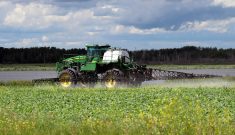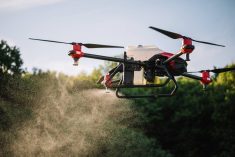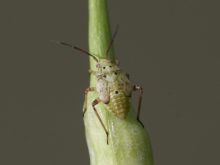With chemical costs continuing to make up a large share of on-farm expenditures, it’s important to prevent any of those compounds from going to waste.
That’s especially true when it comes to pesticides. According to the Farm Inputs Price Index from Statistics Canada, total input costs for Canadian farmers rose by 17.4 per cent in the second quarter of 2022. That included a 7.7 per cent increase in the cost of pesticides during that three-month period (April to June).
Tom Wolf, a sprayer expert and scientist at Agrimetrix Research and Training based in Saskatoon who has more than 30 years of research experience in spray technology, says there are some simple steps farmers can take to significantly reduce the amount of pesticides being wasted on their farms. He spoke on the subject at this year’s CropConnect Conference, held Feb. 15-16 in Winnipeg.
Read Also

Claas brings 1000 Series SP forage harvesters to Canada
In mid-August, Claas unveiled its new line of Jaguar forage harvesters at an event in Visalia, California, deep in the heart of that state’s dairy region.
Wolf said the importance of applying pesticides in the most efficient manner possible was driven home this past year when supply chain issues caused a sharp increase in the costs of pesticides, which saw the cost of glyphosate rise to as much as $15 a litre. That made even simple tasks such as a pre-seed burndown far more expensive.
LOSS SCENARIOS
There are typically five primary areas where pesticides are wasted on a farm. One of the most common ones, Wolf said, is priming a boom with chemical when heading out into the field. Another one is overlap, which accounts for about four per cent of pesticide waste in Western Canada in cases where nozzle-by-nozzle sectional control isn’t used. Tank cleanout waste, boom cleanout waste and drift loss round out the list.
Wolf presented several possible scenarios to show how much pesticide can be wasted without a farmer realizing it.
In the first, 160 acres were sprayed at a rate of 10 gallons per acre using a 1,200-gallon tank and 120-foot boom. A total of 1,600 gallons of pesticide were applied with 24 gallons wasted due to priming, 64 to overlap, 60 to tank cleanout, 48 to boom cleanout and 32 to drift loss. The total loss was 228 gallons or 14.3 per cent of the total amount of pesticide used.

A similar scenario with an application rate of five gallons per acre of 800 gallons of product on 160 acres resulted in 24 gallons of priming waste, 32 gallons of overlap waste, 60 gallons of tank cleanout waste, 48 gallons of boom cleanout waste and 18 gallons of drift loss. The total loss was 180 gallons or 22.5 per cent of the pesticide used being wasted.
In another scenario, 1,000 acres were sprayed at a rate of 10 gallons per acre using a 1,200-gallon tank and 120-foot boom. In that case, 10,000 gallons were applied with 24 gallons wasted due to priming, 400 to overlap, 60 to tank cleanout, 48 to boom cleanout and 200 to drift loss. This resulted in 732 gallons wasted or a total of 7.3 per cent.
IMPROVED PLUMBING
Wolf said there are several different possible solutions available to farmers to help reduce the amount of pesticide waste on their farms. Most include some kind of “plumbing” improvements.
One of those solutions gaining traction is the recirculating boom. It offers waste-free priming that is part of a pump circulation system that allows the operator to push the liquid to the boom and then back to the tank without having to spray a drop.
Not only does it save money in terms of reducing the amount of pesticide wasted, but it also saves time since booms can be primed as operators are driving to their fields rather than them having to sit and wait for the booms to become primed.
An increasingly popular variation of the recirculating boom system features a three-way valve. This provides the option of allowing the return line to go back to the tank or allow the pumped flow to the return side so the boom ends up being pressurized on both ends.
Wolf said there are a growing number of options to choose from when it comes to recirculating booms, including models manufactured in North America and Europe. Several companies are also offering retrofit kits to convert a variety of makes and models of older boom sprayers into recirculating booms.
Wolf said some of the most popular and well-designed circulating booms include the RoGator LiquidLogic C series, John Deere’s Pressure Recirculation and Product Reclaim, Pattison Liquid’s Connect Sniper and Agrifac’s Condor Endurance. Retrofit options include one from Australia-based Arag that is available in Canada through Nozzle Ninja and is designed for John Deere R series and Case Patriot sprayers, and another from Raven for Case Patriot sprayers with Aim Command HD and ISOBUS terminal.
MINIMAL PLUMBING
Wolf said one of the features to consider when purchasing a recirculating boom is “minimal plumbing,” which allows more pesticide to return to the tank and not to the ground.
He also recommended choosing a system that features stainless steel tubing rather than rubber since steel hoses don’t absorb pesticides the way rubber ones do.
A three-way return valve connected to the pressure line is another important consideration, he said, since it allows pesticide left over in the boom to be sprayed on crops during cleanout rather than simply dumping it on the ground when spraying is completed.

Another potential cost-saving device is the Accu-Volume System. It measures and displays in real time the amount of solution within a sprayer tank, both inside the cabin and at the load station.
Wolf said the beauty of the system is it allows operators to fill their tanks with exactly the amount of pesticide they require for a field rather than overfilling it and dumping any excess left over at the end of spraying.
NUMBER CRUNCHING
Just how much of a difference can this improved plumbing make to the reduction of wasted pesticide?
In a scenario with 160 acres being sprayed at a rate of 10 gallons per acre using a 1,200-gallon tank and 120-foot boom, priming waste was zero while overlap was 16 gallons, tank cleanout accounted for 12 gallons, boom cleanout was 48 gallons and drift loss was 16 gallons for a total of 92 gallons or 5.8 per cent total waste. Compare that with the first two scenarios in which 228 gallons (14.3 per cent) and 180 gallons (22.5 per cent) were wasted.
In a better plumbing scenario in which 1,000 acres were sprayed at a rate of 10 gallons per acre with a 1,200-gallon tank and 120-foot boom resulted in zero priming waste, overlap was 100 gallons, tank cleanout netted 12 gallons lost, boom cleanout amounted to 48 gallons and drift loss was 100 gallons. That resulted in just 260 gallons being lost or 2.6 per cent. In the earlier scenario, 732 gallons of sprayed pesticide were wasted or a total of 7.3 per cent.
“We’ve not just saved chemical, we’ve also saved time,” Wolf said. “That’s important to remember.”
Wolf said it’s also important for growers to remember the effect travel speed can have on pesticide waste. The higher the speed, the greater the risk of wasting valuable chemicals.
“If you do the logistics right, you will have the time to go low and slow and do a better job,” said Wolf.
















